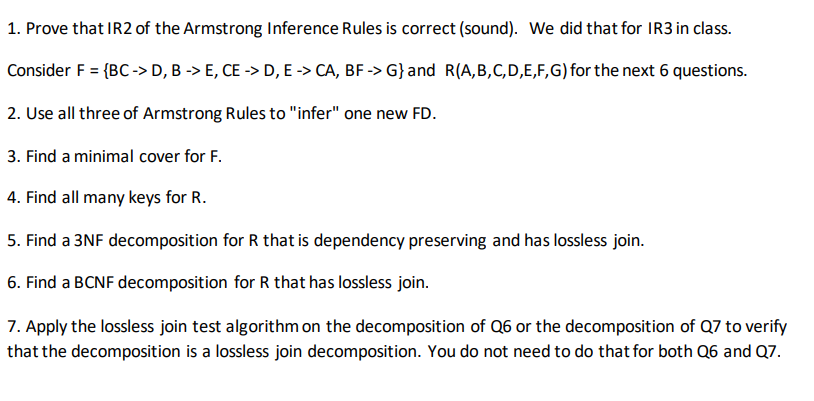1. Prove that IR2 of the Armstrong Inference Rules is correct (sound). We did that for IR3 in class. Consider F = {BC -> D, B -> E, CE -> D, E -> CA, BF -> G}and R(A,B,C, D,E,F,G) for the next 6 questions. 2. Use all three of Armstrong Rules to "infer" one new FD. 3. Find a minimal cover for F. 4. Find all many keys for R. 5. Find a 3NF decomposition for R that is dependency preserving and has lossless join. 6. Find a BCNF decomposition for R that has lossless join. 7. Apply the lossless join test algorithm on the decomposition of Q6 or the decomposition of Q7 to verif that the decomposition is a lossless join decomposition. You do not need to do that for both Q6 and Q7
1. Prove that IR2 of the Armstrong Inference Rules is correct (sound). We did that for IR3 in class. Consider F = {BC -> D, B -> E, CE -> D, E -> CA, BF -> G}and R(A,B,C, D,E,F,G) for the next 6 questions. 2. Use all three of Armstrong Rules to "infer" one new FD. 3. Find a minimal cover for F. 4. Find all many keys for R. 5. Find a 3NF decomposition for R that is dependency preserving and has lossless join. 6. Find a BCNF decomposition for R that has lossless join. 7. Apply the lossless join test algorithm on the decomposition of Q6 or the decomposition of Q7 to verif that the decomposition is a lossless join decomposition. You do not need to do that for both Q6 and Q7
Computer Networking: A Top-Down Approach (7th Edition)
7th Edition
ISBN:9780133594140
Author:James Kurose, Keith Ross
Publisher:James Kurose, Keith Ross
Chapter1: Computer Networks And The Internet
Section: Chapter Questions
Problem R1RQ: What is the difference between a host and an end system? List several different types of end...
Related questions
Question

Transcribed Image Text:1. Prove that IR2 of the Armstrong Inference Rules is correct (sound). We did that for IR3 in class.
Consider F = {BC -> D, B -> E, CE -> D, E -> CA, BF -> G}and R(A,B,C,D,E,F,G) for the next 6 questions.
2. Use all three of Armstrong Rules to "infer" one new FD.
3. Find a minimal cover for F.
4. Find all many keys for R.
5. Find a 3NF decomposition for R that is dependency preserving and has lossless join.
6. Find a BCNF decomposition for R that has lossless join.
7. Apply the lossless join test algorithm on the decomposition of Q6 or the decomposition of Q7 to verify
that the decomposition is a lossless join decomposition. You do not need to do that for both Q6 and Q7.
Expert Solution
This question has been solved!
Explore an expertly crafted, step-by-step solution for a thorough understanding of key concepts.
This is a popular solution!
Trending now
This is a popular solution!
Step by step
Solved in 4 steps

Recommended textbooks for you

Computer Networking: A Top-Down Approach (7th Edi…
Computer Engineering
ISBN:
9780133594140
Author:
James Kurose, Keith Ross
Publisher:
PEARSON

Computer Organization and Design MIPS Edition, Fi…
Computer Engineering
ISBN:
9780124077263
Author:
David A. Patterson, John L. Hennessy
Publisher:
Elsevier Science

Network+ Guide to Networks (MindTap Course List)
Computer Engineering
ISBN:
9781337569330
Author:
Jill West, Tamara Dean, Jean Andrews
Publisher:
Cengage Learning

Computer Networking: A Top-Down Approach (7th Edi…
Computer Engineering
ISBN:
9780133594140
Author:
James Kurose, Keith Ross
Publisher:
PEARSON

Computer Organization and Design MIPS Edition, Fi…
Computer Engineering
ISBN:
9780124077263
Author:
David A. Patterson, John L. Hennessy
Publisher:
Elsevier Science

Network+ Guide to Networks (MindTap Course List)
Computer Engineering
ISBN:
9781337569330
Author:
Jill West, Tamara Dean, Jean Andrews
Publisher:
Cengage Learning

Concepts of Database Management
Computer Engineering
ISBN:
9781337093422
Author:
Joy L. Starks, Philip J. Pratt, Mary Z. Last
Publisher:
Cengage Learning

Prelude to Programming
Computer Engineering
ISBN:
9780133750423
Author:
VENIT, Stewart
Publisher:
Pearson Education

Sc Business Data Communications and Networking, T…
Computer Engineering
ISBN:
9781119368830
Author:
FITZGERALD
Publisher:
WILEY